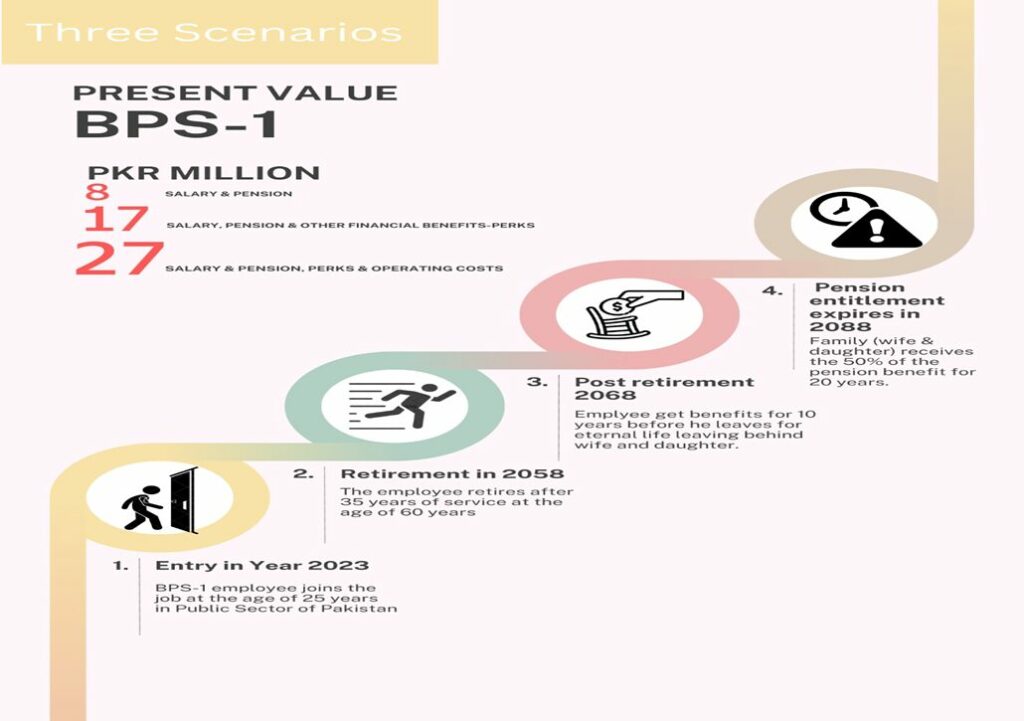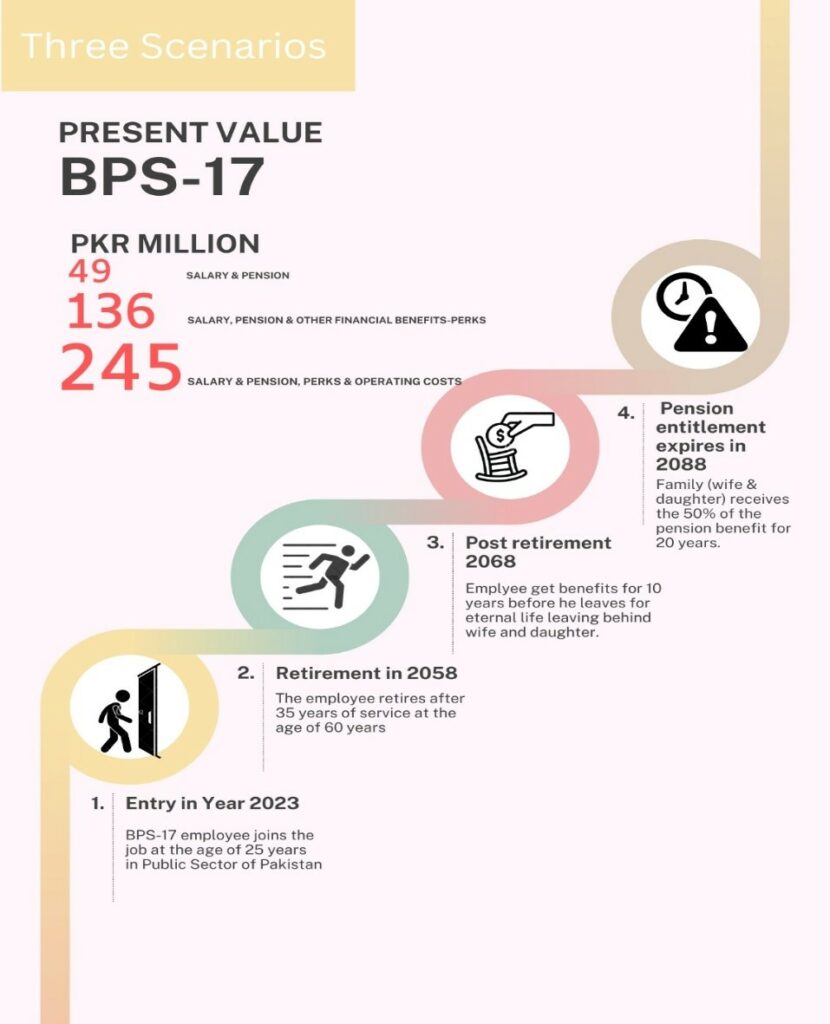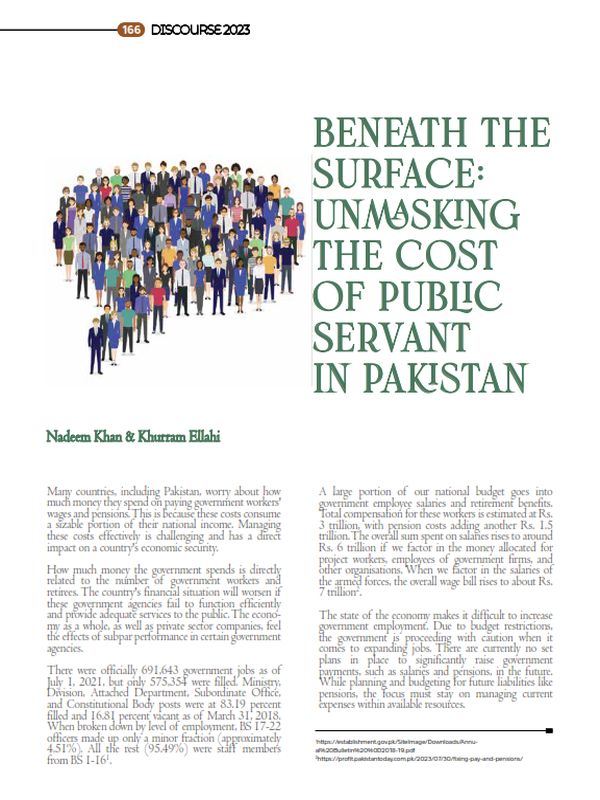
Pakistan Institute of Development Economics
- Home
Our Portals
MenuMenuMenuMenuMenuMenuMenu - ResearchMenuMenuMenuMenuMenuMenuMenu
- Discourse
- The PDR
- Our Researchers
- Academics
- Degree Verification
- Thesis Portal
- Our Portals
Beneath the Surface: Unmasking the Cost of Public Servant in Pakistan
Many countries, including Pakistan, worry about how much money they spend on paying government workers’ wages and pensions. This is because these costs consume a sizable portion of their national income. Managing these costs effectively is challenging and has a direct impact on a country’s economic security.
How much money the government spends is directly related to the number of government workers and retirees. The country’s financial situation will worsen if these government agencies fail to function efficiently and provide adequate services to the public. The economy as a whole, as well as private sector companies, feel the effects of subpar performance in certain government agencies.
There were officially 691,643 government jobs as of July 1, 2021, but only 575,354 were filled. Ministry, Division, Attached Department, Subordinate Office, and Constitutional Body posts were at 83.19 percent filled and 16.81 percent vacant as of March 31, 2018. When broken down by level of employment, BS 17-22 officers made up only a minor fraction (approximately 4.51%). All the rest (95.49%) were staff members from BS 1-16.[1]
A large portion of our national budget goes into government employee salaries and retirement benefits. Total compensation for these workers is estimated at Rs. 3 trillion, with pension costs adding another Rs. 1.5 trillion. The overall sum spent on salaries rises to around Rs. 6 trillion if we factor in the money allocated for project workers, employees of government firms, and other organisations. When we factor in the salaries of the armed forces, the overall wage bill rises to about Rs. 7 trillion.[2]
The state of the economy makes it difficult to increase government employment. Due to budget restrictions, the government is proceeding with caution when it comes to expanding jobs. There are currently no set plans in place to significantly raise government payments, such as salaries and pensions, in the future. While planning and budgeting for future liabilities like pensions, the focus must stay on managing current expenses within available resources. Before committing to significant increases in government size and payments, it is vital to assure the long-term viability of government finances and to rejuvenate economic development.
Pakistan’s government has a tremendous financial burden due to the large number of inefficient government employees. Politicians enjoy the privilege of favouritism within the public sector since they know the taxpayer will be responsible for the costs without any say in the matter. When someone is employed, the budget must account for their future salary and pension, as well as the salaries and pensions of their widows and daughters who have never married.
Inadvertently, workers are hired depending on the whims of higher ups, without taking into account the whole cost of employing that person over the course of their working life. We need to know if we can afford to keep this person on the payroll for the next 30 years before we hire them.
As the number of government workers grows, it is essential to question hiring managers about how much those workers will ultimately cost the government.
According to PIDE’s research, suggesting someone for a BPS 1 position is the equivalent of offering them Rs. 8 million upon employment. The government pays this amount to the worker throughout their employment and continues to do so as a pension once they retire (Figure I). The total price rises to Rs. 17 million once we account for all perks and other costs; and the sum rises to Rs. 27 million once we factor in the operational expenses associated with the BPS-1 worker.
Figure 1. Cost of Public Sector Employees (BPS-1)

Similarly, BPS-17 has a far higher cost per employee than BPS-1. Over the course of a person’s life, a new employee will cost a company Rs. 49 million in BPS-17. When other perks are included in, however, the cost to the Pakistani government for a single worker increases to Rs. 136. When factoring in operational expenditures, as depicted in Figure II, the total cost rises to 245,000,000 PKR.
Figure 2. Cost of Public Sector Employees (BPS-17)

The findings of PIDE are used as a foundation for estimating the potential future financial burden on Pakistani public employees. Pakistan is facing serious economic difficulties as a result of the increasing number of inefficient government employees. These picks are often made for political reasons rather than because of the candidate’s actual merits. Taxpayers are feeling the pinch as a result of the strain on the national budget.
In the event of a government employee’s death, their pension will continue to be paid for as long as they have any unmarried daughters or surviving spouses. This research provides an estimate of the costs connected with these pledges, which is vital for preventing future generations from enduring their burden.
In Pakistan, senior authorities routinely issue appointment orders without first assessing staffing needs or developing strategic plans. Government efficiency is not improved by politically motivated, poorly implemented hiring. The government must shoulder the entire financial load. One of the main causes of low productivity in many government agencies, especially autonomous entities, is flawed recruitment practices.
In short, the government gifts these monies to those who are nonproductive and produce nothing in their jobs. Therefore, the cost of compensating these ineffective workers falls on the public. Additionally, the presence of unproductive employees presents additional challenges that have the potential to harm the organisation’s reputation and achievements.
The authors are faculty members at the Pakistan Institute of Development Economics (PIDE), Islamabad.
[1] https://establishment.gov.pk/SiteImage/Downloads/Annual%20Bulletin%20%0D2018-19.pdf
[2] https://profit.pakistantoday.com.pk/2023/07/30/fixing-pay-and-pensions/



